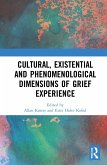New Techniques of Grief Therapy
Bereavement and Beyond
Herausgeber: Neimeyer, Robert A
New Techniques of Grief Therapy
Bereavement and Beyond
Herausgeber: Neimeyer, Robert A
- Gebundenes Buch
- Merkliste
- Auf die Merkliste
- Bewerten Bewerten
- Teilen
- Produkt teilen
- Produkterinnerung
- Produkterinnerung
New Techniques of Grief Therapy: Bereavement and Beyond expands on the mission of the previous two Techniques books, featuring innovative approaches to address the needs of those whose lives have been shadowed by loss.
Andere Kunden interessierten sich auch für
![Disenfranchised Grief Disenfranchised Grief]() Disenfranchised Grief174,99 €
Disenfranchised Grief174,99 €![Cultural, Existential and Phenomenological Dimensions of Grief Experience Cultural, Existential and Phenomenological Dimensions of Grief Experience]() Cultural, Existential and Phenomenological Dimensions of Grief Experience187,99 €
Cultural, Existential and Phenomenological Dimensions of Grief Experience187,99 €![Family Therapy Techniques Family Therapy Techniques]() Jon CarlsonFamily Therapy Techniques189,99 €
Jon CarlsonFamily Therapy Techniques189,99 €![Grieving Beyond Gender Grieving Beyond Gender]() Kenneth J DokaGrieving Beyond Gender189,99 €
Kenneth J DokaGrieving Beyond Gender189,99 €![Loss, Grief, and Attachment in Life Transitions Loss, Grief, and Attachment in Life Transitions]() Jakob van WielinkLoss, Grief, and Attachment in Life Transitions175,99 €
Jakob van WielinkLoss, Grief, and Attachment in Life Transitions175,99 €![Techniques in Adlerian Psychology Techniques in Adlerian Psychology]() Jon CarlsonTechniques in Adlerian Psychology162,99 €
Jon CarlsonTechniques in Adlerian Psychology162,99 €![Responding to Men in Crisis Responding to Men in Crisis]() Brian TaylorResponding to Men in Crisis196,99 €
Brian TaylorResponding to Men in Crisis196,99 €-
-
-
New Techniques of Grief Therapy: Bereavement and Beyond expands on the mission of the previous two Techniques books, featuring innovative approaches to address the needs of those whose lives have been shadowed by loss.
Hinweis: Dieser Artikel kann nur an eine deutsche Lieferadresse ausgeliefert werden.
Hinweis: Dieser Artikel kann nur an eine deutsche Lieferadresse ausgeliefert werden.
Produktdetails
- Produktdetails
- Verlag: Taylor & Francis
- Seitenzahl: 352
- Erscheinungstermin: 30. September 2021
- Englisch
- Abmessung: 254mm x 178mm x 21mm
- Gewicht: 844g
- ISBN-13: 9780815352020
- ISBN-10: 0815352026
- Artikelnr.: 62229256
- Herstellerkennzeichnung
- Libri GmbH
- Europaallee 1
- 36244 Bad Hersfeld
- gpsr@libri.de
- Verlag: Taylor & Francis
- Seitenzahl: 352
- Erscheinungstermin: 30. September 2021
- Englisch
- Abmessung: 254mm x 178mm x 21mm
- Gewicht: 844g
- ISBN-13: 9780815352020
- ISBN-10: 0815352026
- Artikelnr.: 62229256
- Herstellerkennzeichnung
- Libri GmbH
- Europaallee 1
- 36244 Bad Hersfeld
- gpsr@libri.de
Robert A. Neimeyer, PhD, is Professor Emeritus of Psychology at the University of Memphis and Director of the Portland Institute for Loss and Transition, which provides online and onsite training in grief therapy for an international and interdisciplinary community of professionals. Neimeyer has published over 30 books, including Techniques of Grief Therapy: Assessment and Intervention and Grief and the Expressive Arts: Practices for Creating Meaning, the latter with Barbara Thompson. He serves as editor of the journal Death Studies. The author of over 500 articles and book chapters and a frequent workshop presenter, he is currently working to advance a more adequate theory of grieving as a meaning-making process. Neimeyer served as president of the Association for Death Education and Counseling (ADEC) and chair of the International Work Group for Death, Dying, and Bereavement. In recognition of his scholarly contributions, he has been granted the Eminent Faculty Award by the University of Memphis, made a fellow of the Clinical Psychology Division of the American Psychological Association, and given Lifetime Achievement Awards by both the Association for Death Education and Counseling and the International Network on Personal Meaning.
Foreword by Darcy Harris
Part I. Framing the Work
1. Reconstructing the Continuing Bond: A Process Analysis of Grief Therapy
2. The Meaning in Loss Group: Principles, Processes and Procedures
3. Culturally Sensitive Approaches to Finding Meaning in Traumatic Bereavement
4. Suffering a Death Wish: The Psychology of Medical Aid in Dying
5. Grief after Non-Death Losses
6. Posttraumatic Growth and Expert Companionship in Grief Therapy
Part II. Evaluating Grief
7. The Persistent Complex Bereavement Inventory (PCBI)
8. The Social Meaning in Life Events Scale (SMILES)
9. Quality of Relationships Inventory-Bereavement Version (QRI-B)
10. Death Imagery Scale
Part III. Moving through Bereavement
11. The Grieving Styles Grid
12. The Grief Dance
13. Walking the Labyrinth
14. Drawing it Out
Part IV. Articulating Ambiguous Loss
15. What Have You Lost?
16. Letters to Love, Time and Death
17. The Human Animal Bond
Part V. Practicing Self Care
18. MyGrief.ca Online Support
19. Differentiating Grief and Depression
20. Concentrated Eye Gazing
21. Dance and Movement for Therapist Self-Care
Part VI. Fostering Compassion
22. Forgiveness Therapy
23. Writing A Letter of Condolence
24. Thematic Analysis
Part VII. Working with Emotion
25. Balancing Caring and Daring
26. Externalizing Conversations
27. The Castle
28. Redecision and Reaffirmation
29. Figurative Stories
Part VIII. Utilizing Imagery
30. Mindful Photography
31. My House After Loss
32. The Virgin Island
33. The Gate of My Heart
Part IX. Revising Personal Meaning
34. Re-composing the Self in the Wake of Loss
35. Memory Reconsolidation
36. The Identity Constellation Exercise
37. Voice Dialogue
38. Symbolic Reframing
39. Coin Therapy
Part X. Reaffirming Attachment
40. The Transition Cycle
41. Creating a Sensory Portal
42. Working with Blocks
43. The Secure Base Map
44. Player of Life
45. Habits of the Heart
Part XI. Dialoguing with the Deceased
46. Consulting the Deceased
47. Interviewing the Internalized Other
48. Induced After Death Communication
Part XII. Validating Lives
49. Dignity Therapy
50. A Hike to Remember
51. The Sharing Plate
52. Life Lessons Learned
Part XIII. Re-storying Loss
53. Grief Dialogues
54. Response Writing Dialogues
55. Writing to Heal
56. Karuna Cards
Part XIV. Facilitating Support
57. Envisioning Transitions
58. The Meaningful Conversation
59. Dyadic Eye Gazing.
Part I. Framing the Work
1. Reconstructing the Continuing Bond: A Process Analysis of Grief Therapy
2. The Meaning in Loss Group: Principles, Processes and Procedures
3. Culturally Sensitive Approaches to Finding Meaning in Traumatic Bereavement
4. Suffering a Death Wish: The Psychology of Medical Aid in Dying
5. Grief after Non-Death Losses
6. Posttraumatic Growth and Expert Companionship in Grief Therapy
Part II. Evaluating Grief
7. The Persistent Complex Bereavement Inventory (PCBI)
8. The Social Meaning in Life Events Scale (SMILES)
9. Quality of Relationships Inventory-Bereavement Version (QRI-B)
10. Death Imagery Scale
Part III. Moving through Bereavement
11. The Grieving Styles Grid
12. The Grief Dance
13. Walking the Labyrinth
14. Drawing it Out
Part IV. Articulating Ambiguous Loss
15. What Have You Lost?
16. Letters to Love, Time and Death
17. The Human Animal Bond
Part V. Practicing Self Care
18. MyGrief.ca Online Support
19. Differentiating Grief and Depression
20. Concentrated Eye Gazing
21. Dance and Movement for Therapist Self-Care
Part VI. Fostering Compassion
22. Forgiveness Therapy
23. Writing A Letter of Condolence
24. Thematic Analysis
Part VII. Working with Emotion
25. Balancing Caring and Daring
26. Externalizing Conversations
27. The Castle
28. Redecision and Reaffirmation
29. Figurative Stories
Part VIII. Utilizing Imagery
30. Mindful Photography
31. My House After Loss
32. The Virgin Island
33. The Gate of My Heart
Part IX. Revising Personal Meaning
34. Re-composing the Self in the Wake of Loss
35. Memory Reconsolidation
36. The Identity Constellation Exercise
37. Voice Dialogue
38. Symbolic Reframing
39. Coin Therapy
Part X. Reaffirming Attachment
40. The Transition Cycle
41. Creating a Sensory Portal
42. Working with Blocks
43. The Secure Base Map
44. Player of Life
45. Habits of the Heart
Part XI. Dialoguing with the Deceased
46. Consulting the Deceased
47. Interviewing the Internalized Other
48. Induced After Death Communication
Part XII. Validating Lives
49. Dignity Therapy
50. A Hike to Remember
51. The Sharing Plate
52. Life Lessons Learned
Part XIII. Re-storying Loss
53. Grief Dialogues
54. Response Writing Dialogues
55. Writing to Heal
56. Karuna Cards
Part XIV. Facilitating Support
57. Envisioning Transitions
58. The Meaningful Conversation
59. Dyadic Eye Gazing.
Foreword by Darcy Harris
Part I. Framing the Work
1. Reconstructing the Continuing Bond: A Process Analysis of Grief Therapy
2. The Meaning in Loss Group: Principles, Processes and Procedures
3. Culturally Sensitive Approaches to Finding Meaning in Traumatic Bereavement
4. Suffering a Death Wish: The Psychology of Medical Aid in Dying
5. Grief after Non-Death Losses
6. Posttraumatic Growth and Expert Companionship in Grief Therapy
Part II. Evaluating Grief
7. The Persistent Complex Bereavement Inventory (PCBI)
8. The Social Meaning in Life Events Scale (SMILES)
9. Quality of Relationships Inventory-Bereavement Version (QRI-B)
10. Death Imagery Scale
Part III. Moving through Bereavement
11. The Grieving Styles Grid
12. The Grief Dance
13. Walking the Labyrinth
14. Drawing it Out
Part IV. Articulating Ambiguous Loss
15. What Have You Lost?
16. Letters to Love, Time and Death
17. The Human Animal Bond
Part V. Practicing Self Care
18. MyGrief.ca Online Support
19. Differentiating Grief and Depression
20. Concentrated Eye Gazing
21. Dance and Movement for Therapist Self-Care
Part VI. Fostering Compassion
22. Forgiveness Therapy
23. Writing A Letter of Condolence
24. Thematic Analysis
Part VII. Working with Emotion
25. Balancing Caring and Daring
26. Externalizing Conversations
27. The Castle
28. Redecision and Reaffirmation
29. Figurative Stories
Part VIII. Utilizing Imagery
30. Mindful Photography
31. My House After Loss
32. The Virgin Island
33. The Gate of My Heart
Part IX. Revising Personal Meaning
34. Re-composing the Self in the Wake of Loss
35. Memory Reconsolidation
36. The Identity Constellation Exercise
37. Voice Dialogue
38. Symbolic Reframing
39. Coin Therapy
Part X. Reaffirming Attachment
40. The Transition Cycle
41. Creating a Sensory Portal
42. Working with Blocks
43. The Secure Base Map
44. Player of Life
45. Habits of the Heart
Part XI. Dialoguing with the Deceased
46. Consulting the Deceased
47. Interviewing the Internalized Other
48. Induced After Death Communication
Part XII. Validating Lives
49. Dignity Therapy
50. A Hike to Remember
51. The Sharing Plate
52. Life Lessons Learned
Part XIII. Re-storying Loss
53. Grief Dialogues
54. Response Writing Dialogues
55. Writing to Heal
56. Karuna Cards
Part XIV. Facilitating Support
57. Envisioning Transitions
58. The Meaningful Conversation
59. Dyadic Eye Gazing.
Part I. Framing the Work
1. Reconstructing the Continuing Bond: A Process Analysis of Grief Therapy
2. The Meaning in Loss Group: Principles, Processes and Procedures
3. Culturally Sensitive Approaches to Finding Meaning in Traumatic Bereavement
4. Suffering a Death Wish: The Psychology of Medical Aid in Dying
5. Grief after Non-Death Losses
6. Posttraumatic Growth and Expert Companionship in Grief Therapy
Part II. Evaluating Grief
7. The Persistent Complex Bereavement Inventory (PCBI)
8. The Social Meaning in Life Events Scale (SMILES)
9. Quality of Relationships Inventory-Bereavement Version (QRI-B)
10. Death Imagery Scale
Part III. Moving through Bereavement
11. The Grieving Styles Grid
12. The Grief Dance
13. Walking the Labyrinth
14. Drawing it Out
Part IV. Articulating Ambiguous Loss
15. What Have You Lost?
16. Letters to Love, Time and Death
17. The Human Animal Bond
Part V. Practicing Self Care
18. MyGrief.ca Online Support
19. Differentiating Grief and Depression
20. Concentrated Eye Gazing
21. Dance and Movement for Therapist Self-Care
Part VI. Fostering Compassion
22. Forgiveness Therapy
23. Writing A Letter of Condolence
24. Thematic Analysis
Part VII. Working with Emotion
25. Balancing Caring and Daring
26. Externalizing Conversations
27. The Castle
28. Redecision and Reaffirmation
29. Figurative Stories
Part VIII. Utilizing Imagery
30. Mindful Photography
31. My House After Loss
32. The Virgin Island
33. The Gate of My Heart
Part IX. Revising Personal Meaning
34. Re-composing the Self in the Wake of Loss
35. Memory Reconsolidation
36. The Identity Constellation Exercise
37. Voice Dialogue
38. Symbolic Reframing
39. Coin Therapy
Part X. Reaffirming Attachment
40. The Transition Cycle
41. Creating a Sensory Portal
42. Working with Blocks
43. The Secure Base Map
44. Player of Life
45. Habits of the Heart
Part XI. Dialoguing with the Deceased
46. Consulting the Deceased
47. Interviewing the Internalized Other
48. Induced After Death Communication
Part XII. Validating Lives
49. Dignity Therapy
50. A Hike to Remember
51. The Sharing Plate
52. Life Lessons Learned
Part XIII. Re-storying Loss
53. Grief Dialogues
54. Response Writing Dialogues
55. Writing to Heal
56. Karuna Cards
Part XIV. Facilitating Support
57. Envisioning Transitions
58. The Meaningful Conversation
59. Dyadic Eye Gazing.








